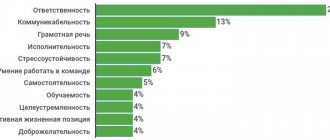Each inhabitant of our vast planet has its own basic needs, even the simplest ones - single-celled ones. If all the needs experienced are not met, the creature will not be able to function normally, feel comfort and enjoy life. Humanity has a significant number of requests that must be fulfilled in a timely manner in order to continue to live. In this article I will talk in detail about the physiological needs of a person and give a detailed definition of what they are.
Explanation of concepts
Biological needs are the most significant and valuable, as they ensure life. Even a slight denial of satisfaction can lead to negative consequences (illness, organ system disorders, weakness, death).
A need is a request that must be immediately fulfilled in order for the individual to feel good:
- felt protected;
- was important to others;
- functioned normally without any disruptions to the body;
- achieved goals and made dreams come true;
- felt satisfied.
Human physical needs are a type of need, failure to fulfill which leads to loss of life. If a person cannot support them, he will lose the opportunity to achieve goals, and if they are not satisfied at all, diseases and dysfunctions of the body will appear, which will lead to unnamed death (this does not apply to the desire for procreation).
Examples of biological queries:
- eating high-calorie foods for energy and sustenance;
- rest and sleep;
- air;
- liquid;
- desires of a sexual nature and procreation.
They are the lowest needs. They are required to be performed not only by human beings, but also by representatives of the entire animal world, even insects. However, in the simplest organisms this list is not so large.
What it is?
A need is a certain need that must be satisfied in order for a person to feel good: to be protected, to realize that he is important to his environment and society as a whole, to be able to function productively, achieve his goals, feel satisfaction, and so on.
Physiological needs , which are also called vital, are a type of needs that allow a person to maintain vital functions.
If a person fails to maintain them at the proper level, the ability to achieve higher goals will be impaired. death will occur after some time (with the exception of the need to satisfy sexual desire).
In Maslow's pyramid of needs, physiological needs are the basis for all others and represent a kind of foundation.
What are the physiological needs of a person? Examples of vital needs :
- the need to obtain food and liquids sufficient in calories to maintain existence and perform certain activities;
- need for rest;
- need to sleep;
- need for breathing;
- the opportunity to satisfy sexual desire and prolong the race.
These needs are considered lower .
Not only people, but also animals, insects and other creatures need their satisfaction.
A number of simple creatures have a shorter list of physiological needs.
What classification of physiological needs exists: examples of manifestation in humans
Achievement orientation implies demands to be stronger, more responsible, smarter, and to have the best-paid job. Sometimes, in order to achieve as much as possible, a person puts biological needs in the background, forgetting to fulfill them. But unfortunately, there are cases when they push aside not only their own needs, but also the needs of their children, enrolling them in various clubs from birth: music section, drawing, dancing. The result of such haste may be failure to eat or rest. This will lead to the manifestation of psychological disorders.
Nutrition
Food brings energy, pleasure, and satisfaction to the body. A refreshed person is more balanced and cheerful than a hungry person. Having the opportunity to have a snack is not enough; it is necessary that the food be high in calories and harmless. If an individual is engaged in physical labor and often attends training, he should consume as many calories as possible, and those who carry out activities through mental labor should consume less. The need is considered satisfied if the diet contains enough nutrients to lead a normal life, without quickly getting tired and without exhausting the body.
Digestive functions:
- Filling the body with the necessary beneficial elements that help maintain vital activity and produce new cells.
- Providing energy for the struggle for existence and an active lifestyle.
- Transferring information to maintain connection with nature.
In the history of mankind, hunger and thirst are the causes of wars and the formation of nomads, but we know this only from textbooks. Currently, another problem has arisen - diet pills that reduce appetite; the desire of girls to become thin, which leads to anorexia.
The human body is designed this way: in order to avoid a lack of essential carbohydrates, it focuses on preserving energy reserves, turning them into fat deposits, which retain beneficial properties in the organs. During a prolonged fast, the body will use stored reserve substances so that the person can exist for some more time.
Psychologist Daria Milai
Make an appointment
Without food, a person will live from 1 to 2 months if she drinks liquid. Without water you can only function for 3-7 days, and then you die. In the process of exhaustion of the body due to lack of nutrients, the psyche begins to deteriorate, this leads to:
- hallucinations;
- delirious;
- irritability;
- aggressiveness.
If children starve, their development begins to slow down.
Hidden fasting is eating food that does not contain the required amount of beneficial properties. This is a common problem for people who are experiencing financial difficulties. They constantly develop various types of diseases.
Diet standards for physiological nutritional needs
- Liquid - from 1.5 to 2.5 liters per day (a lot of water comes with food).
- Kcal - depends on gender, weight, type of physical activity. The norm may vary, but on average it ranges from 2,000 to 3,000 kilocalories.
- Protein - from 35 to 87 g per day.
- Fats - daily intake from 60 to 150 g.
- Carbohydrates - from 255-585 g per day.
Liquid
When engaging in sports or work, a person loses a large amount of water during the day with:
- urination;
- sweating;
- breathing;
- defecation.
The consequences of dehydration are very serious as it can be fatal. It is necessary to constantly monitor the water balance and restore it in time. An individual can live without fluid for only a few days. That is why such a need is one of the first on the list of basic needs, without which it is impossible to properly perform one’s functions. To correctly calculate your daily water intake, be sure to take into account your individual characteristics and lifestyle.
Sleep and rest
The absence of these two components leads to poor functioning in society. During night or daytime sleep, our brain processes all the information received during the day and helps maintain immunity. Also, when a person falls asleep, all toxicity disappears from the brain organ.
Face-to-face consultation
What are the features and advantages of face-to-face consultation?
Find out more
Skype consultation
What are the features and benefits of Skype consultations?
Find out more
Rest is no less important, a person will not be able to do one thing for several hours without breaks, it quickly exhausts him, so it is necessary to periodically give himself the opportunity to rest and be distracted from work for at least a few minutes.
If a person constantly spends sleepless nights, does not sleep when he really wants to, does not take rest when he needs it, a gradual mental disorder will occur - neurosis, depression. Stress may also arise, which is extremely difficult for such a person to resist.
If an individual often lacks sleep, his cognitive qualities will noticeably decrease and the likelihood of developing various infectious diseases, mental illnesses and emotional imbalances will increase.
Inadequate sleep (less than 5-6 hours a day) can lead to:
- obesity;
- oncology;
- stroke;
- diabetes mellitus;
- diseases of the cardiovascular system;
- early death.
If you suffer from insomnia due to your activities, do not allow yourself the required number of hours of sleep, and experience discomfort, be sure to make an appointment with a doctor to prevent negative consequences - hallucinations and delusions. Such a person always feels tired, is unable to fix attention on one thing, becomes extremely irritable and has an increased pain threshold.
Microsleep is a sudden falling asleep for just a few seconds, which occurs in people who are accustomed to denying themselves rest. This is a serious deviation that contributes to accidents. For example, you might fall asleep momentarily while driving and cause a traffic accident. However, you don't even realize that you've fallen asleep for a while. The rest rate should be 7-9 hours a day.
Air
We cannot live even 5 minutes without such a need. Lack of oxygen will kill an individual in a very short period of time. An important condition is the absence of toxic impurities in the air, otherwise the risk of many diseases will increase sharply, including oncology.
Sexual attraction and procreation
If such a desire is not satisfied, no negative consequences will occur; he is able to continue living, but the quality of life may decrease, especially if libido is overly expressed. Nowadays, the great need to leave behind heirs is slowly fading away, and making love is a sign of a love relationship, intimacy and pleasure.
Several centuries ago, the need for procreation was almost the most important, since during periods of wars and incurable diseases people were threatened with gradual extinction. The evolutionary process proves that those species that produce large numbers of offspring have a high rate of survival.
If sexual desires are not fulfilled, the person becomes unhappy. However, for some, this need is reduced, so they do not have attachment to these love sensations.
Assexuals are a type of people who do not strive for sex (and if they practice it, it is only to conceive a baby).
The excitement gradually builds up and then turns into an angry and aggressive state. Such anger penetrates the mind and can be the cause of illegal negative actions - crimes. Also, dissatisfaction of desires develops mental illness.
Psychophysiological mechanisms of needs
tags:
Hunger, Feeling, Occurrence, Organism, Human, Biological, Condition, Glucose 1. Psychophysiological mechanisms of needs.
What causes human activity? What motivates him to act?
Analysis of the motivating reasons for behavior allows us to identify needs as the main factor.
Needs are the form of communication between the body and the outside world and the source of its activity. It is the needs, being the internal essential forces of the organism, that prompt it to various forms of activity (activity) necessary for the preservation and development of the individual and the species. The needs of living beings are extremely diverse. There are different approaches to their classification, however, most researchers distinguish three types of needs: biological, social and ideal.
From a biological point of view, a need acts as a need experienced by an organism for something located in the external environment and necessary for its activity. Vital biological needs are necessary to maintain the constancy of the internal environment of the body.
The needs that ensure the normal functioning of the body are the needs for food, water, optimal environmental conditions (oxygen level in the air, air temperature, light level, etc.).
Some biological needs (hunger, thirst) are associated with the need to maintain homeostasis.
The vital biological needs of humans differ from the similar needs of animals. The main difference lies, first of all, in the level of socialization of a person’s vital needs, which can change significantly under the influence of sociocultural factors. For example, the socialization of food needs gave rise to the art of cooking, and the introduction of etiquette when eating.
The physiological conditions for the emergence of needs is an insufficiently developed problem, and some certainty currently exists only in relation to such vital needs as the need for food and water. From a psychological point of view, hunger and thirst are homeostatic drives - drives aimed at obtaining enough water and food for the body to ensure survival. These drives are innate and do not require special learning, but during life they can be modified by various environmental influences.
4 pp., 1595 words
Needs as a source of human activity
... MANIFEST IN TEMPERAMENT, CHARACTER, ABILITIES Needs as a source of human activity Need is the state of a person's need for something that is necessary for his normal ... subject to its own internal laws, in no way connected with either the biological or the social. The body was usually considered as a kind of “container” of mental activity. Views...
The nature of hunger. Energy balance in people is maintained provided that the energy supply matches the energy consumption for muscle work, chemical processes (tissue growth and repair) and heat loss. Lack of food causes hunger, which initiates food-seeking behavior. Under what physiological conditions does the feeling of hunger occur? It was originally assumed that the feeling of hunger arises as a result of contractions of an empty stomach, which can be perceived by mechano-receptors located in the walls of the stomach. According to modern concepts, the decisive role in this is played by glucose dissolved in the blood. Normally, regardless of the quality of food consumed, the concentration of glucose in the blood is maintained between 0.8 and 1.0 g/l. In the diencephalon, liver, and walls of blood vessels of the circulatory system there are chemoreceptors that respond to the concentration of glucose in the blood, the so-called glucoreceptors. Reacting to a decrease in blood glucose, they contribute to the feeling of hunger. It is assumed that the feeling of hunger may also arise as a result of a lack of metabolic products of proteins and fats in the body. In addition, current living conditions may play a certain role in the occurrence of hunger.
It is known that when the ambient temperature decreases, food consumption increases in warm-blooded animals, and in an amount inversely proportional to the existing temperature. Thus, internal thermoreceptors may serve as a source of stimulation that contributes to the sensation of hunger. Along with physiological ones, there are also psychological factors that regulate the feeling of hunger. The diet, including the rhythm of food consumption, the duration of the intervals between meals, its qualitative composition and quantity, certainly influence the occurrence of the feeling of hunger. The desire for certain food is called appetite. It can occur when you feel hungry or outside of it (for example, when you see or describe a particularly tasty dish).
5 pages, 2009 words
Human emotions and feelings
ABSTRACT for the course “Psychology” on the topic: “Human Emotions and Feelings” 1. The concept of emotions and feelings and their physiological basis Feelings play a big role in human life and activity. They enrich his inner world, make his perceptions bright and meaningful, and encourage him to be active. Feelings represent a person’s experience of his relationship to everything that he knows and does...
A specific appetite may reflect a real deficiency of any component in the food composition; for example, a craving for salty foods may arise as a result of the body losing a significant amount of salt. However, such a connection is not always visible. Preference for certain types of food and aversion to others are determined by the individual experience of a person’s upbringing and cultural traditions. The process of food absorption usually stops long before, as a result of its digestion, the energy deficit that caused the feeling of hunger and prompted the start of food absorption disappears. The sum of the processes that force the completion of this act is called saturation. The feeling of satiety is always accompanied by a release of tension (since it is associated with the activation of the parasympathetic system) and positive emotions, therefore, it represents something more than the simple disappearance of hunger.
The nature of the feeling of thirst. The adult human body contains approximately 75% water. When the amount of water lost exceeds 0.5% of body weight (about 350 ml in a person weighing 70 kg), a feeling of thirst occurs. Thirst is a general sensation based on the combined action of many types of receptors located both in the periphery and in the brain. The main nerve structures responsible for the regulation of water-salt balance are located in the diencephalon, mainly in the hypothalamus. In its anterior sections there are so-called osmoreceptors, which are activated when the intracellular concentration of salts increases, i.e. when cells lose water. Osmoreceptors are called receptors for thirst caused by water deficiency in cells. In addition to them, other factors may also take part in the formation of the sensation of thirst, for example, receptors in the oral cavity and pharynx (creating a feeling of dryness), stretch receptors in the walls of large veins, and others. It is important to emphasize that there is no adaptation to the sensation of thirst, so the only way to eliminate it is to consume water.
11 pages, 5473 words
The human body as a single biological system
MINISTRY OF INTERNAL AFFAIRS OF THE RUSSIAN FEDERATION MOSCOW UNIVERSITY Department of Physical Training of the Educational and Scientific Complex of Special Training Approved by Acting Head of the Department of Physical Training of the UNK SP Police Colonel ______________ Khromov V.A Author: Dementyev V.L., Professor, Doctor of Pedagogical Sciences, Professor of the Department of Physical Training of the UNK SP ...
Biochemical correlates of the need for sensations. According to some data, the need for additional stimulation may be determined by certain biochemical characteristics of a person. For example, in the well-known studies of the American psychologist M. Zuckerman, a person’s tendency to search for new experiences, the desire for physical and social risk was studied. This tendency is defined as “sensation seeking.” Using a special questionnaire, you can assess a person’s needs for novelty, strong and thrilling sensations. It has been established that the individual level of need for sensations has its own biochemical prerequisites. The degree of need for sensations is negatively related to the level of the following biochemical indicators: monoamine oxidase (MAO), endorphins and sex hormones. The function of monoamine oxidase is to control and limit the level of certain mediators (in particular, norepinephrine, dopamine).
These mediators ensure the functioning of the neurons of the catecholaminergic system, which is related to the regulation of the emotional states of the individual. If the content of MAO in neurons is reduced (compared to the norm), the biochemical control over the action of these mediators is weakened. Endorphins, biologically active substances produced in the brain, reduce pain sensitivity and have a calming effect on the human psyche. Sex hormones (androgens and estrogens) are associated with the processes of masculinization and feminization. In other words, individuals who produce less MAO, endorphins, and sex hormones in their bodies are more likely to engage in behavior that seeks strong additional stimulation. Zuckerman suggested that sensation seeking is associated with the need to ensure an optimal level of activation in the catecholaminergic system. Therefore, individuals with low levels of catecholamine production will likely seek intense sensations to raise the activity of this system to optimal levels. This example gives reason to believe that over time, biochemical features can be discovered that create conditions for the formation of certain, not only vital, but also ideal human needs. However, we must not lose sight of the fact that correlation as a method of analysis does not provide a basis for assessing cause-and-effect relationships. In principle, it cannot be ruled out that the listed biochemical features themselves arise as a consequence of behavior aimed at seeking sensations, which is formed as a result of the action of some other currently unknown (maybe social) factors.
7 pages, 3458 words
Psychology of human motivation 2
Psychology of human motivation 1. Theoretical analysis of approaches to the psychology of motivation 1.1 Foreign concepts of the psychology of motivation The motivational sphere of a person is still very little studied in psychology. This cannot be explained by a lack of interest in this subject: from ancient times to the present day, the question of the internal drivers of human behavior has steadily occupied scientists and...
2. Motivation.
Motivation is a physiological mechanism that encourages the body to implement behavior aimed at satisfying a pressing need (the term motivation literally means “that which causes movement”).
Need acts as an energy factor that induces the body to a certain behavior.
Motivations and needs should not be equated. Needs are not always converted into motivational arousal; at the same time, without proper motivational arousal, it is impossible to satisfy the corresponding needs. In many life situations, an existing need, for one reason or another, is not accompanied by a motivational impulse to action. Figuratively speaking, need speaks of “what the body needs,” and motivation mobilizes the body’s forces to achieve what is “needed.”
The emergence of motivational arousal can be considered as a special, integrated state of the brain, in which, based on the influence of subcortical structures, the cerebral cortex is involved in the activity.
In the mechanism of development of need into motivation, a key role is played by the threshold value, upon reaching which the growing need leads to the development of motivational arousal.
Thus, a need develops into motivation only after reaching a certain level; when this conditional threshold is exceeded, a person, as a rule, cannot ignore the growing need and the motivation subordinate to it.
7 pages, 3136 words
Conceptual approach to the system of non-material motivation of agricultural workers
CONCEPTUAL APPROACH TO THE SYSTEM OF NON-MATERIAL MOTIVATION OF WORKERS OF AGRICULTURAL ORGANIZATIONS Alekseenko D. S. Krasnoyarsk State Agrarian University, Krasnoyarsk, Russia The article is the completed library research of non-material motivation of agro enterprises, it is manager's guide contains the furbish data related to nowadays. The survey of the relevant problem of …
Motivations are usually divided into lower (primary, simple, biological) and higher (secondary, complex, social).
Biological motivations include hunger, thirst, fear, aggression, sexual desire, care for offspring; social - the desire to pay or not pay taxes.
Biological and social motivations play an important role in developing behavioral goals.
Motivation activates the work of any functional system, primarily afferent synthesis and acceptor of action results. Accordingly, afferent systems are activated (sensory thresholds are reduced, orienting reactions are enhanced) and memory is activated (memory images necessary for search activity, information about similar events that happened in the past are updated).
Motivation creates a special functional state that ensures the body’s readiness to perform the appropriate activity. This condition is characterized by a number of changes.
- the motor system is activated
- The tone of the sympathetic nervous system increases, autonomic reactions increase (blood pressure, vascular reactions, skin conductivity changes).
As a result of these changes, activity increases, which is purposeful in nature, and subjective emotional experiences arise, prompting action. All this is subsequently expressed in human behavior.
Motivation remains throughout the entire behavioral act, determining not only the initial stage of behavior (afferent synthesis), but also all subsequent ones: anticipation of future results, decision-making, its correction based on the acceptor of the results of the action and the changed environmental afferentation. It is the dominant motivation that contributes to the appeal to accumulated and innate behavioral experience, which is necessarily taken into account when developing a behavior program. From this point of view, the acceptor of the result of an action represents the dominant need of the body, transformed by motivation into the form of advanced excitation of the brain.
6 pages, 2600 words
Section “Physiology of sensory systems”
... department of the olfactory analyzer. Ancient cerebral cortex, its connection with the limbic system. Pheromones as a means of intraspecific communication. CONDUCTORY ... obon bulbs (not in humans) – hpt—needs, emotions, vegetatives, endocrine. In people, sex and gender, there is a connection with the motor centers (with the spinal cord, midbrain, cerebellum, cerebral cortex). Structure of the eye: auxiliary organs and...
Thus, motivation turns out to be an essential component of the functional system of behavior. It represents a special state of the body, which, persisting throughout the entire time, from the beginning of a behavioral act to the receipt of useful results, determines the purposeful behavioral activity of the body and the nature of its response to external stimuli.
Due to diversity, different needs often coexist simultaneously, prompting an individual to different, sometimes mutually exclusive, styles of behavior. For example, the need for security (fear) and the need to protect one’s child (maternal instinct) may compete intensely.
That is why there is often a kind of “struggle” of motivations and the building of their hierarchy.
3. Emotions
Emotions are a special class of mental processes and states associated with needs and motives, manifested in the form of direct subjective experiences (satisfaction, joy, fear, etc.).
According to the criterion of the duration of emotional phenomena, they distinguish, firstly, the emotional background (or emotional state), and secondly, the emotional response. These two classes of emotional phenomena are subject to different patterns. The emotional state to a greater extent reflects a person’s general global attitude towards the surrounding situation, towards himself and is associated with his personal characteristics; an emotional response is a short-term emotional response to a particular influence that is situational in nature. The most significant characteristics of emotions are their sign and intensity. Positive and negative emotions are always characterized by a certain intensity.
Accompanying almost any manifestation of human life activity, emotions serve as one of the main mechanisms of internal regulation of mental activity and behavior aimed at satisfying needs.
The emergence and course of emotions is closely related to the activity of the modulating systems of the brain, with the limbic system playing a decisive role.
The limbic system is a collection of a number of brain structures. Participates in the regulation of the functions of internal organs, smell, instinctive behavior, emotions, memory, sleep, wakefulness, etc.
The term "limbic system" was introduced in 1952 by Mac Lean. However, even earlier, in 1937, Papets suggested the presence
The limbic system is based on the Papez circle (“anatomical” emotional ring).
Which included: hippocampus - fornix - mammillary bodies - anterior nucleus of the thalamus - cingulate gyrus - hippocampus. The flow of “feelings” circulates along the anatomical “emotional ring,” thus creating the physiological basis of emotional experiences.
The limbic system, in addition to the Papez ring, usually includes: some nuclei of the hypothalamus, the amygdala, or amygdala (a cellular accumulation the size of a nut), the olfactory bulb, tract and tubercle, nonspecific nuclei of the thalamus and the reticular formation of the midbrain. Together, these morphological structures form a single hypothalamic-limbic-reticular system. The central part of the limbic system is the hippocampus. In addition, there is a point of view that the anterior frontal region is a neocortical extension of the limbic system.
Nerve signals from all senses travel along the brainstem to the cortex and pass through one or more limbic structures - the amygdala, hippocampus, or part of the hypothalamus. Signals emanating from the cortex also pass through these structures. Different parts of the limbic system are differently responsible for the formation of emotions. Their occurrence depends largely on the activity of the amygdala complex and the cingulate gyrus. However, the limbic system takes part in the launch of predominantly those emotional reactions that have already been tested during life experience.
There is compelling evidence that a number of fundamental human emotions have an evolutionary basis. These emotions turn out to be hereditarily fixed in the limbic system.
Reticular formation. The reticular formation of the brain stem plays an important role in the organization of behavior. As is known, fibers from neurons of the reticular formation go to various areas of the cerebral cortex. Most of these neurons are considered “non-specific”, i.e. Unlike neurons of the primary sensory zones, visual or auditory, which respond only to one type of stimulus, neurons of the reticular formation can respond to many types of stimuli. These neurons transmit signals from all sensory organs (eyes, skin, muscles, internal organs, etc.) to the structures of the limbic system and the cerebral cortex.
Some areas of the reticular formation have more specific functions. For example, a special section of the reticular formation, called the locus coeruleus (this is a dense cluster of neurons, the processes of which form widely branching networks with one output, using norepinephrine as a transmitter), is related to the awakening of emotions. From the locus coeruleus to the thalamus, hypothalamus and many areas of the cortex there are nerve pathways along which an awakened emotional reaction can spread widely throughout all structures of the brain. According to some reports, a lack of norepinephrine in the brain leads to depression. The positive effect of electroconvulsive therapy, which in most cases eliminates depression in the patient, is associated with increased synthesis and increased concentration of norepinephrine in the brain. The results of a study of the brain of patients who committed suicide in a state of depression showed that it is depleted of norepinephrine and serotonin. It is possible that norepinephrine plays a role in the occurrence of reactions subjectively perceived as pleasure. In any case, a deficiency of norepinephrine manifests itself in the appearance of depressive states associated with melancholy, and a lack of adrenaline is associated with depression and anxiety.
Another section of the reticular formation, called the substantia nigra, is a collection of neurons that also form widely branching networks with one output, but secrete another transmitter - dopamine, which contributes to the emergence of pleasant sensations. It is possible that it is involved in the emergence of a special mental state - euphoria.
Of all parts of the cerebral cortex, the frontal lobes of the cerebral cortex are most responsible for the occurrence and awareness of emotional experiences. Direct neural pathways from the thalamus, limbic system, and reticular formation go to the frontal lobes.
Injuries to people in the frontal lobes of the brain show that most often they experience mood changes from euphoria to depression, as well as a kind of loss of orientation, expressed in the inability to make plans. Sometimes mental changes resemble depression: the patient exhibits apathy, loss of initiative, emotional inhibition, and indifference to sex. Sometimes the changes are similar to psychopathic behavior: sensitivity to social signals is lost, incontinence in behavior and speech appears.
Interhemispheric asymmetry and emotions. There are many facts indicating that the left and right hemispheres of the brain make different contributions to the emotional sphere of a person. The right hemisphere is more emotional. Thus, in healthy people, an advantage was found for the left half of the visual field (i.e., the right hemisphere) when assessing facial expression, as well as the left ear (also the right hemisphere) when assessing the emotional tone of the voice and other auditory manifestations of human feelings (laughter, crying) , when perceiving musical fragments. In addition, more intense expressions of emotions (facial expressions) were also revealed on the left half of the face. There is also an opinion that the left half of the face reflects negative emotions to a greater extent, while the right half reflects positive emotions. According to some data, these differences already appear in infants, in particular in the asymmetry of facial expressions during the taste perception of sweet and bitter.
It is known from the clinic that emotional disturbances with damage to the right hemisphere are more pronounced, and there is a selective deterioration in the ability to evaluate and identify emotional expression in facial expressions. With left-sided lesions, patients often experience attacks of anxiety, restlessness and fear, and the intensity of negative emotional experiences increases. Patients with lesions of the right hemisphere are more characterized by states of complacency, cheerfulness, and indifference to others. They have difficulty assessing moods and identifying the emotional components of other people's speech. Clinical observations of patients with pathological obsessive laughter or crying show that pathological laughter is often associated with right-sided lesions, and pathological crying with left-sided lesions.
According to some ideas, the left hemisphere is responsible for the perception and expression of positive emotions, and the right hemisphere is responsible for negative ones. Depressive experiences that arise when the left hemisphere is damaged are considered as a result of disinhibition of the right, and euphoria, which often accompanies damage to the right hemisphere, is considered as a result of disinhibition of the left.
There are other approaches to describing the specifics of interhemispheric interaction in providing emotions. For example, it has been suggested that the right hemisphere's tendency to synthesize and integrate multiple signals into a global image plays a critical role in the production and stimulation of emotional experience. At the same time, the advantage of the left hemisphere in the analysis of individual, temporally ordered and clearly defined details is used to modify and weaken emotional reactions. Thus, the cognitive and emotional functions of both hemispheres are closely related both in the cognitive sphere and in the regulation of emotions.
According to other ideas, each hemisphere has its own emotional “vision” of the world. At the same time, the right hemisphere, which is considered as a source of unconscious motivation, unlike the left, perceives the world around us in an unpleasant, threatening light, but it is the left hemisphere that dominates in organizing a holistic emotional experience at a conscious level. Thus, cortical regulation of emotions is carried out normally during the interaction of the hemispheres.
In a holistic behavioral reaction, needs, motivations and emotions appear in an inextricable unity, however, they reflect the activity of, although closely interacting, specialized departments of the central nervous system, and also perform different functions in ensuring behavior.
Bibliography:
- Bloom F., Leiserson A., Horstedter L. Brain, mind and behavior. M.: Mir, 1988.
- Danilova N.N., Krylova A.L. Physiology of higher nervous activity. M.: MSU, 1989.
- Maryutina T.M., Introduction to psychophysiology. M. Flint, 2005.
- Milner P. Physiological psychology. M.: Mir, 1973.
- Khomskaya E.D., Bashova N.Ya. Brain and emotions. M., 1992.
11
What relates to the needs of children and adults: a list of physiological needs
The baby’s needs are not significantly different; they also need nutritious and healthy food, regular rest, and fresh air. Daily correct diet of baby food:
- From 1 year to 4 years – 3.5 grams of protein per 1 kg (the baby’s weight is multiplied by the indicated indicator), 4 g of fat and 12 g of carbohydrates.
- From 4 to 7 years – the weight is approximately the same. 3.5 grams protein, 3 g fat. 16 g carbohydrates.
- Schoolchildren - their diet is gradually narrowing. 2.5 g protein, 2.5 g fat, 13 g carbohydrates.
Mother's milk is a balanced drink suitable for a child up to 1 year old. If breastfeeding is not possible, consult a doctor, he will suggest the best food option suitable for the child, taking into account all his needs. Recommended amount of sleep for children:
- up to 6 months – 16-20 hours a day;
- from six months to one and a half years – 14-15 hours a day;
- from 1 year to 7 years – 12-14 hours;
- from 8 to adulthood – 8-10 hours.
Also, during mental activity, the child should be given breaks of 5 to 20 minutes for rest.
The needs of an adult are not very different from those of children; they are also supplemented by the instinct for procreation. If this desire is ignored, the person may become aggressive and not control his actions. But this happens in rare cases. If a person’s psychological state is adequate, he understands that such a request is important for health, but is not given to it at any convenient opportunity. The ideal and stable manifestation of sexual desires is observed in marriage or long-term relationships with a beloved partner.
Ask a question
Advantages and disadvantages
As is easy to see, the pyramid of needs is not just a classification of them, but reflects a certain hierarchy: instinctive needs, basic, sublime. Every person experiences all these desires, but the following pattern comes into force here: basic needs are considered dominant, and higher-order needs are activated only when the basic ones are satisfied. But it should be understood that needs can be expressed completely differently for each person. And this happens at any level of the pyramid. For this reason, a person must correctly understand his desires, learn to interpret them and adequately satisfy them, otherwise he will constantly be in a state of dissatisfaction and disappointment. By the way, Abraham Maslow took the position that only 2% of all people reach the fifth stage.
What are your true needs and motives? Find out in the Self-Knowledge course.
We also recommend reading:
- Storytelling
- McClelland's theory of motivation
- Self-actualization
- Using Maslow's pyramid for self-actualization
- Abraham Maslow "Motivation and Personality" - summary
- 6 Skills to Develop Emotional Intelligence
- Pyramid of Minto. Principles
- Kano model for analyzing a product or service
- Herzberg's two-factor theory of motivation
- 3 Eco-Friendly Ways to Get What You Need from Someone
- Spiral dynamics model
Key words:1Self-knowledge
How not to become addicted
Sometimes a person experiences a constant desire that develops into addiction, for example: to eat or sleep a lot. This is facilitated by psychological and physical health problems. There is a whole list of mental illnesses that are associated with food. Such diseases have the abbreviation Eating Disorder, which stands for eating disorder. This includes:
- excessive thinness (anorexia);
- bulimia with unhealthy weight control;
- binge eating;
- desire for healthy and proper nutrition;
- bigorexia.
A specialist will help you cope with such deviations. If you do not contact him in time, additional mental disorders may occur:
- depression;
- neurosis;
- anxiety;
- PTSD.
Excessive appetite also indicates hormonal diseases in the body that occur when taking any medications. If you notice a constant craving for food and this has been going on for a long time, immediately consult a doctor for help. Such a frequent need for food and sleep is a sign of various kinds of psychological or physical disorders. For example, people suffering from chronic health problems need rest more than healthy individuals. However, in a strong body, a condition such as hypersomnia (excessive sleep and the manifestation of constant drowsiness) can occur. It manifests itself after stressful situations, during a long period without relaxation, or when taking medications. It can also occur for the following reasons:
- head injury;
- depression;
- uremia;
- apnea.
In order not to be a hostage to the needs of physiology, listen to your body and prevent alarming signals by contacting a doctor or psychotherapist.
What other needs are there besides biological?
The creator of the pyramid of values, A. Maslow, considered the physiological need to be leading in something. This unique table in the form of a triangle gained great popularity, and psychologists, marketers, advertising specialists and management professionals immediately began to use it in their activities.
The basis of the pyramid is made up of biological needs, which I listed in detail above, the second step is occupied by the need for security (the presence of comfort, coziness, stable work). At the third level there are social values (communication, being in the spotlight). The fourth stage consists of prestigious needs - respect, recognition, self-sufficiency and independence. And the last level is spiritual values (art, creativity).
Why satisfy a need?
A. Maslow listed desires from bottom to top. Since only when the lowest level is satisfied can one move on to the next one. Spiritual and social needs are necessary and important, but when feeling hungry and lack of sleep, the individual will show indifference to them. In the Middle Ages, such schemes were specifically used by dominant tyrants and generals. They believed that an individual suffering from hunger was easier to control than a well-fed one.
Unsatisfied biological desires deprive the possibility of thinking, rational reasoning, striving for freedom, and achieving goals. Therefore, keeping your body in good shape, constantly paying attention to it and fulfilling all requests is an important rule for full functioning in life.










